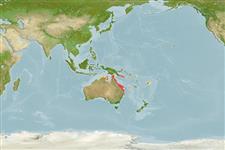Common names from other countries
Environment: milieu / climate zone / depth range / distribution range
Ecology
Marine; reef-associated; depth range 1 - 15 m (Ref. 9710). Tropical; 10°S - 33°S
Western Pacific: restricted to the Great Barrier Reef, adjacent coastal areas, and Lord Howe Island.
Size / Weight / Age
Maturity: Lm ? range ? - ? cm
Max length : 15.0 cm TL male/unsexed; (Ref. 4859)
Found in areas of sparse coral growth. Feed on algae and small benthic invertebrates (Ref. 2334). Oviparous (Ref. 205). Form pairs during breeding (Ref. 205). Heavy algae growth should always be maintained in the aquarium.
Life cycle and mating behavior
Maturity | Reproduction | Spawning | Eggs | Fecundity | Larvae
Distinct pairing (Ref. 205). Monogamous mating is observed as both obligate and social (Ref. 52884).
Steene, R.C., 1978. Butterfly and angelfishes of the world. A.H. & A.W. Reed Pty Ltd., Australia. vol. 1. 144 p. (Ref. 4859)
IUCN Red List Status (Ref. 130435)
CITES (Ref. 128078)
Not Evaluated
Threat to humans
Harmless
Human uses
Aquarium: commercial
More information
ReferencesAquacultureAquaculture profileStrainsGeneticsElectrophoresesHeritabilityDiseasesProcessingMass conversion
Tools
Special reports
Download XML
Internet sources
Estimates based on models
Preferred temperature (Ref.
115969): 24.3 - 28.1, mean 26.4 (based on 369 cells).
Phylogenetic diversity index (Ref.
82804): PD
50 = 0.5000 [Uniqueness, from 0.5 = low to 2.0 = high].
Bayesian length-weight: a=0.02291 (0.01133 - 0.04632), b=3.00 (2.83 - 3.17), in cm Total Length, based on LWR estimates for this Genus-body shape (Ref.
93245).
Trophic level (Ref.
69278): 2.8 ±0.25 se; based on food items.
Resilience (Ref.
120179): High, minimum population doubling time less than 15 months (Preliminary K or Fecundity.).
Fishing Vulnerability (Ref.
59153): Low vulnerability (10 of 100).
